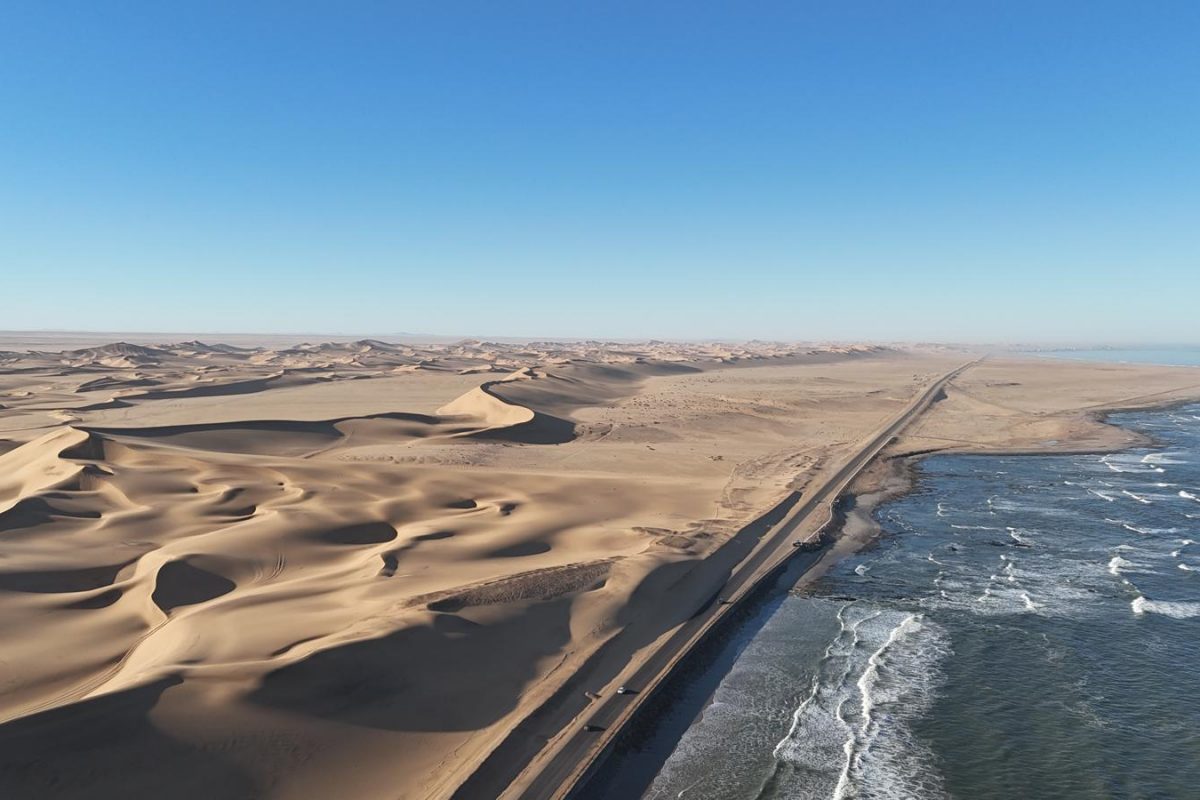

Namibia is one of the safest and easiest to navigate on yourself countries. Despite what you read online, the roads are in very good condition and you do not actually need a 4 wheel drive, unless you plan to drive in the sand in Sossusvlei area or play catch with the desert adapted elephants near Twyfelfontain. Keep reading if you want to find more.
When? Namibia is best visited during the dry season, which unsurprisingly coincides with the most crowded period of time in terms of tourism. But, the country is so vast, that we barely saw any human being while traveling its roads. We also picked the beginning of the dry season, late June/early July. The period is good for wildlife watching that congregates around the few waterholes. Just like when we visited the Atacama, it rained heavily in Solitaire, close to Sossusvlei and the Namib desert. So yeah…dry season.
Flights. Vienna to Windhoek with layovers in Frankfurt and Munchen (for the return trip). 650 euro/adult with 23kg checked baggage. Not sure if it was a good deal or not. We have 2h delays because of storms, 13h delay because of technical issues (we lost one day in Namibia due to these), a cancelled flight back home (final leg, but rescheduled on the same day a couple of hours later).
Visa. We opted for a visa on arrival. Online visa info here: https://eservices.mhaiss.gov.na. There were less people queuing for the VOA, but it still took a lot of time to get through. Prices: 1600 NAD/adult and 800 NAD/kid, payable in cash of card.
Entering and existing Namibia with kids. Namibia is fighting against human trafficking. Several regulations are in place when traveling with a minor. To enter/exit Namibia with our 8yo, we needed his birth certificate (they request that you carry it in original or a legalized copy!). We had a nightmare with this certificate, that nearly made us miss the flight, so be careful!
Money. 100 N$ =5 EUR. Several ATMs are available in large towns (Windhoek, Walvis Bay, Swakopmund, Outjo, etc). We used FNB without charges. We also used revolut to pay the entry to national parks, dinner in restaurants, accommodation and gas. Sometimes because of the lack of service, the internet may be down and card payment can become difficult. Having cash comes in handy. We had about 12000 NAD in cash for 3 adults and 1 child.
Opening times for most parks. They open at sunrise and close at sunset. Check before. I usually use this website: https://www.sunrise-and-sunset.com/en/sun/namibia/windhoek/2025/june
Roads. All kind of roads and in different conditions. Mostly good. Driving on the left side of the road. We read multiple reviews and online travel blogs that suggested the need of a 4×4 vehicle. We paid a lot of money for a very well equipped vehicle. In the end, we only needed the 4-wheel drive to get from the 2-wheel drive parking lot in Sossusvlei to the actual start of the hiking trail for Deadvlei (this part of the road can be done using one of the shuttles available there). The second time we needed the 4-wheel drive was in the Ugab river, following the desert adapted elephants near Twyfelfontain (can be done via a booked tour).
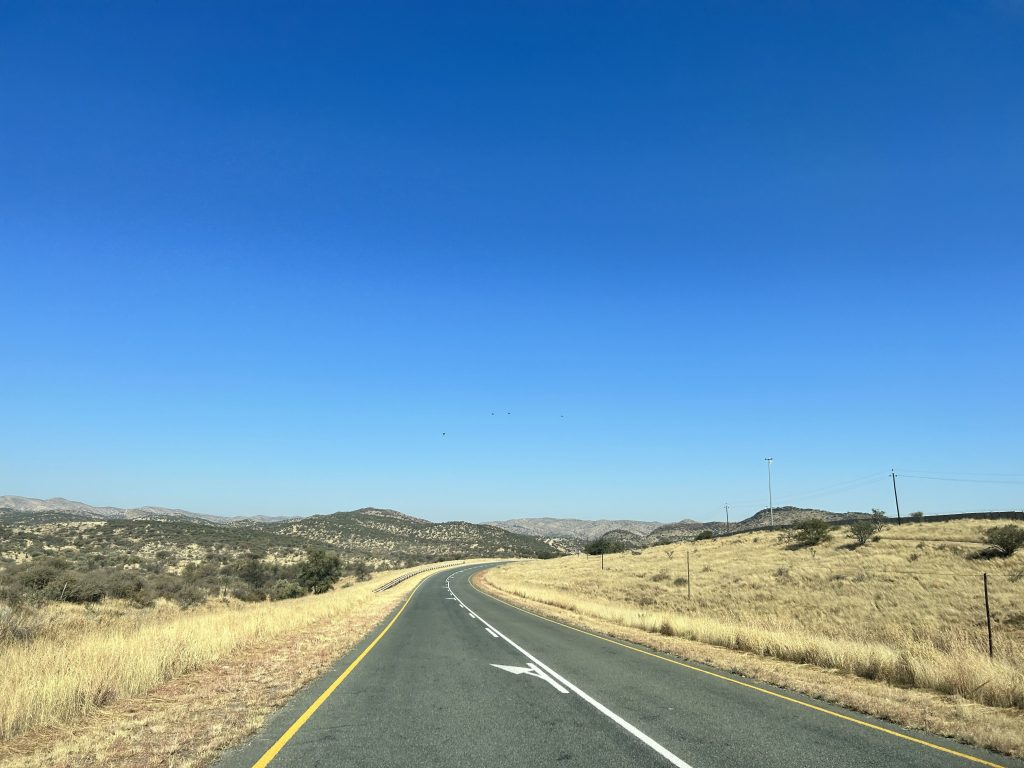
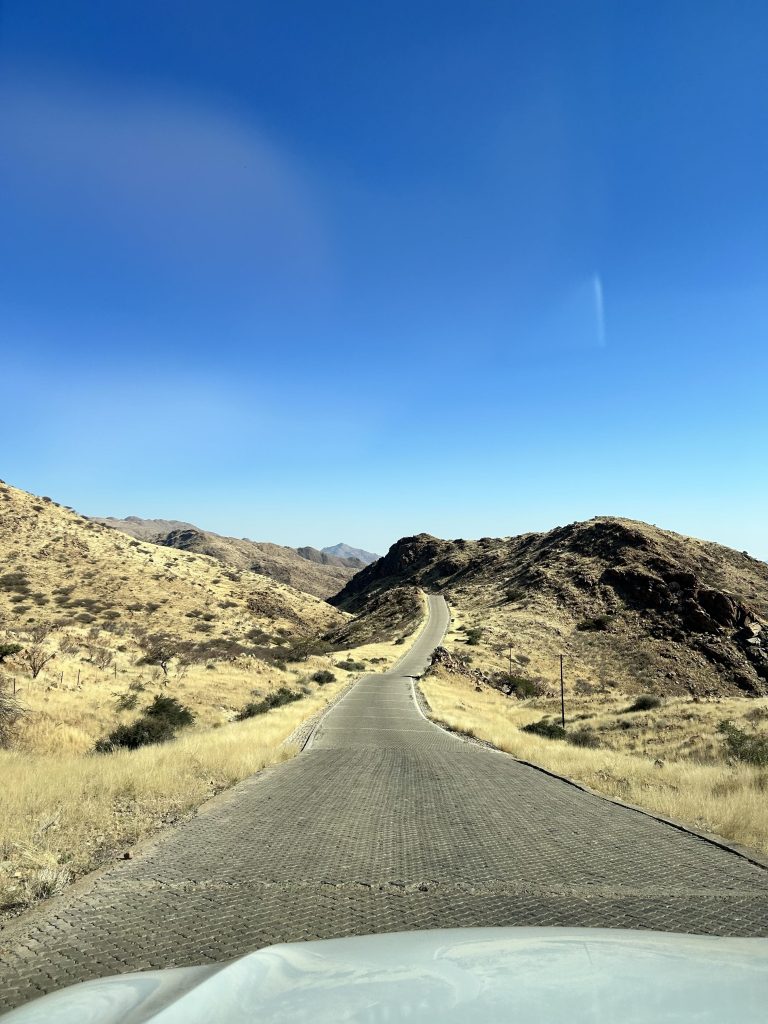






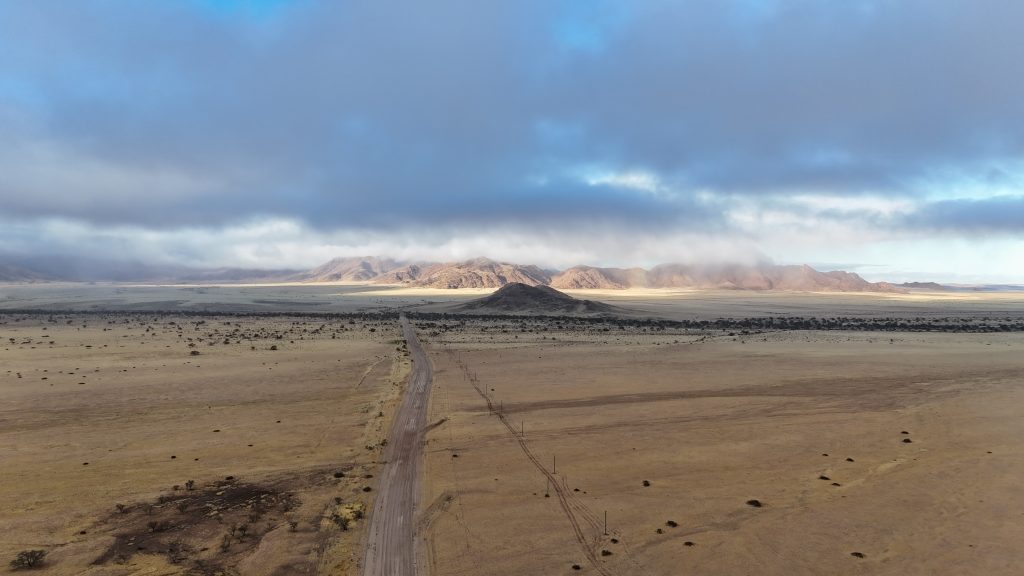
Car rental. We chose Advanced Cire Hire, located in Windhoek. Well, we opted for a 4-wheel drive, as I just mentioned. A Toyota Fortuner equipped with a large fridge (with a batter to keep food/drinks cool even when the engine is turned off), a secondary gas tank (which we could have lived without, as our itinerary did not include traveling for long in remote areas), a spare tire and several insurance options (to avoid the massive deposit). Total price: 1000 Eur/ 10 days. They picked us up when we arrived and took us to the airport on our last day. Contact: https://www.advancedcarhire.com.
Food. We had breakfast on the go (bought from supermarkets) and picnics for lunch (as we were constantly moving). There are several picnic spots along the main roads (with concrete tables and benches). But we stopped randomly to eat, whenever we wanted just on the side of the road. We only dined in restaurants in the evenings. Restaurants recommendations follow below in our itinerary.

Itinerary + accommodation + restaurants
Day 1. We arrived late evening in Windhoek and spent the first night close to the car hire company at Deluxe Residence Windhoek (75 euro, highly recommended, very clean, aircon working, very spacious). We initially booked the night at Desert Quiver Camp, but never made it there because of a flight delay (the resort fully reimbursed our money, they were amazing).
Day 2. Solitaire. After we picked up the car and did grocery shopping in a Checkers store, part of The Grove Mall, filled up the tank on our car and drove 3h to Solitaire. The road all the way to Solitaire is gravel, but easy to manage, speed up to 80-90km/hour. Road D1275 is a winding steep way that is closed for large vehicles. Stop at Spreetshoogte Pass (Google maps: https://maps.app.goo.gl/wcfuPxfiA7vFxQcP6) with great views of the Namib Naukluft national park. Solitaire is famous for its old abandoned cars and its apple pie, claimed to be the best in Namibia. It was good, but not fabulous 😊. McGregor’s Bakery sells all kinds of pastries and snacks, not just the apple pie.
Accommodation: Solitaire roadhouse (155 Eur, breakfast included). Dinner: Café Van Der Lee, next to the accommodation.

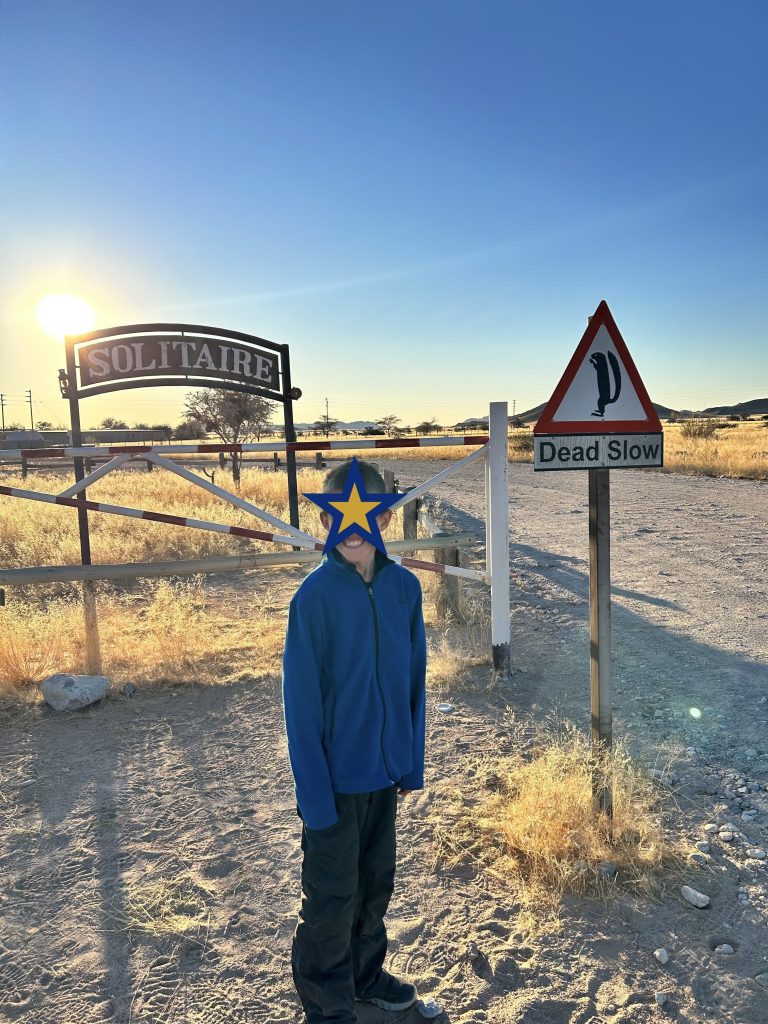
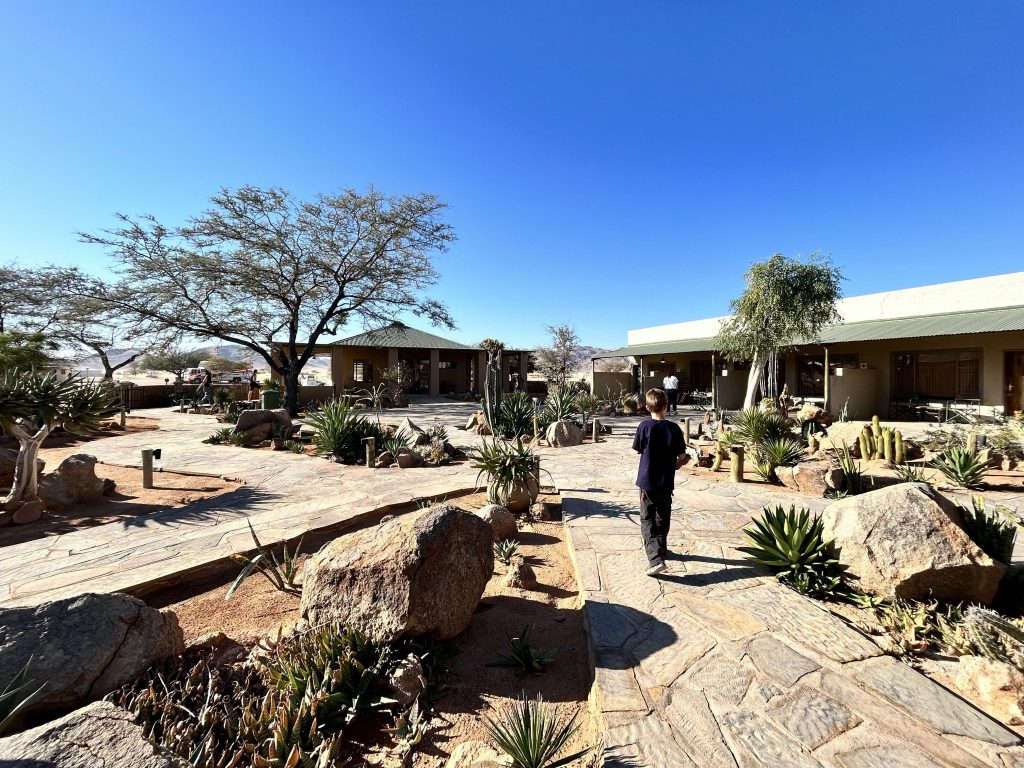

Day 3. We had to cut short on various sights that we had planned because of our 13h flight delay. But we kept the gem of Namibia and probably its most photographed spot. Sossusvlei. We drove 1h to Sesriem, the gate to the Sossusvlei area. At the gate, a ranger took our license plate and number of people in the car and directed us towards the inner (second gate). If you are accommodated like us, outside the outer gate, then the opening times are dawn to dusk (if you are accommodated inside the park, between the outer and inner gates, you are permitted to enter the park 1h earlier and remain inside the park 1h later than sunset).
We reached the outer gate at 10 AM. Normally this is a bad time as the road to Sossusvlei and Deadvlei takes about 1h. Getting there at 11-12AM would be terrible beacuse of the desert heat. But yesterday, we experienced unsual weather and temperatures. It rained and the maximum expected temperature in Deadvlei was 14 degrees. So, upon reaching the outer gate we were given a registration number (no need to step out of the car, the ranger comes to meet you). We used the registration number at the inner gate ticket office. Here, we paid 150 NAD/adult and 50 NAD/car. Kids pay 50 NAD, but they did not charge us for our 8 year old. Credit card payment is possible. More info here: https://www.nwrnamibia.com/sesriem-entry-price.htm.
From here, the road is paved and well maintained. The paved road ends at the first parking lot (for 2WD) and takes about 50min. If you have a 4×4, you can drive yourself further to the beginning of the trail to Deadvlei. The drive is on a sandy track up to the second parking. Deflate tyres. If you need help, the rangers can deflate them for you (to 1.5-1.6). Tips are welcomed (50 NAD). The sand drive is super fun and well worth the experience. From the second parking lot, white poles mark the trail to Deadvlei. The trail goes over small dunes over about 1.5km.
Dune hiking: You can also choose to hike Big Daddy Dune, the tallest one in the area. But Deadvlei is the highlight here, with its white washed clay pan surrounded by red dunes and the bluest skies. The 1000 year old black trees can only complement the landscape.
Alternative dune hiking: Big Mamma Dune, Dune 45 or Dune 40, on the paved road. The latter two have a parking nearby from where you can continue on foot.
To inflate the tyres, we drove back and exited the outer gate. The petrol station is on the right, at the Sossus Oasis. We asked someone to help us and paid 50NAD.
If you do not have a 4 wheel drive car, then there are shuttle vans going from the first parking to the beginning of the Deadvlei trail. It costs N$200 for adults and N$100 for children.
Alternative hiking options:
- Hiddenvlei is little visisted compared to the most famous Deadvlei. The trail starts from the first parking and takes about 2km and it is marked with wooden poles.
- Sesriem Canyon
After visiting Deadvlei, we drove back to Solitaire and tried their famous apple pie before driving further to our next stop in Walvis Bay.
Accommodation: Anas Inn Walvis Bay (130 euro/ 2nights, two bedroom apartment, no breakfast). Dinner: We ate some seafood at the Raft restaurant. It was okish, we recommend going in a different place. See below.



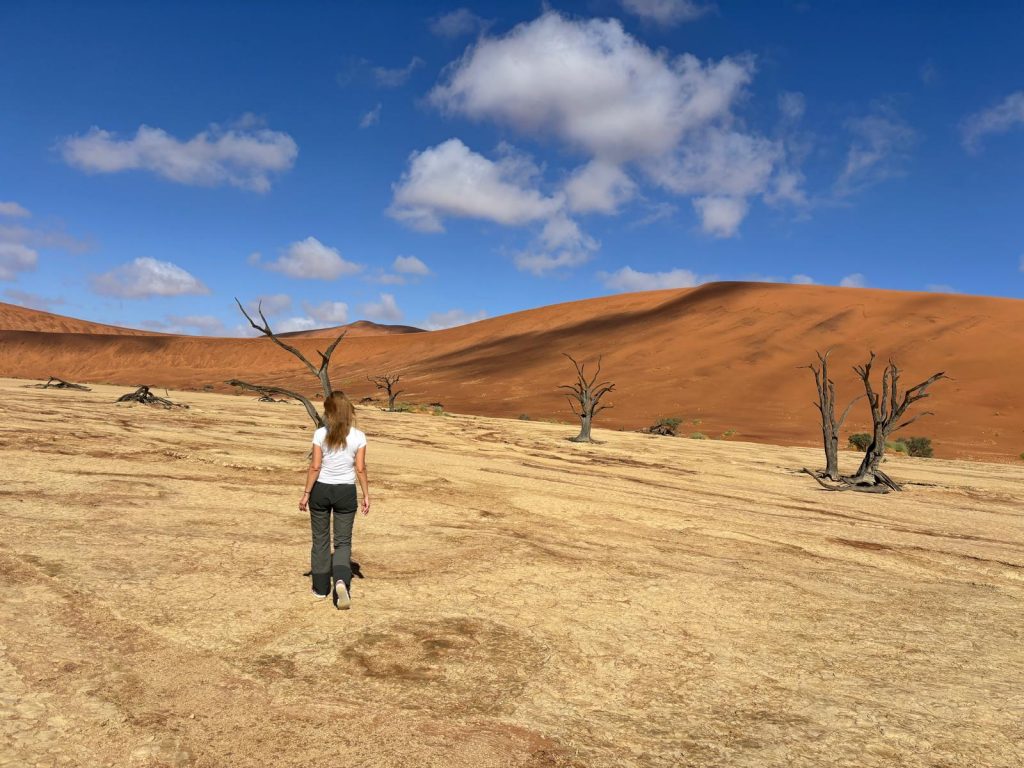
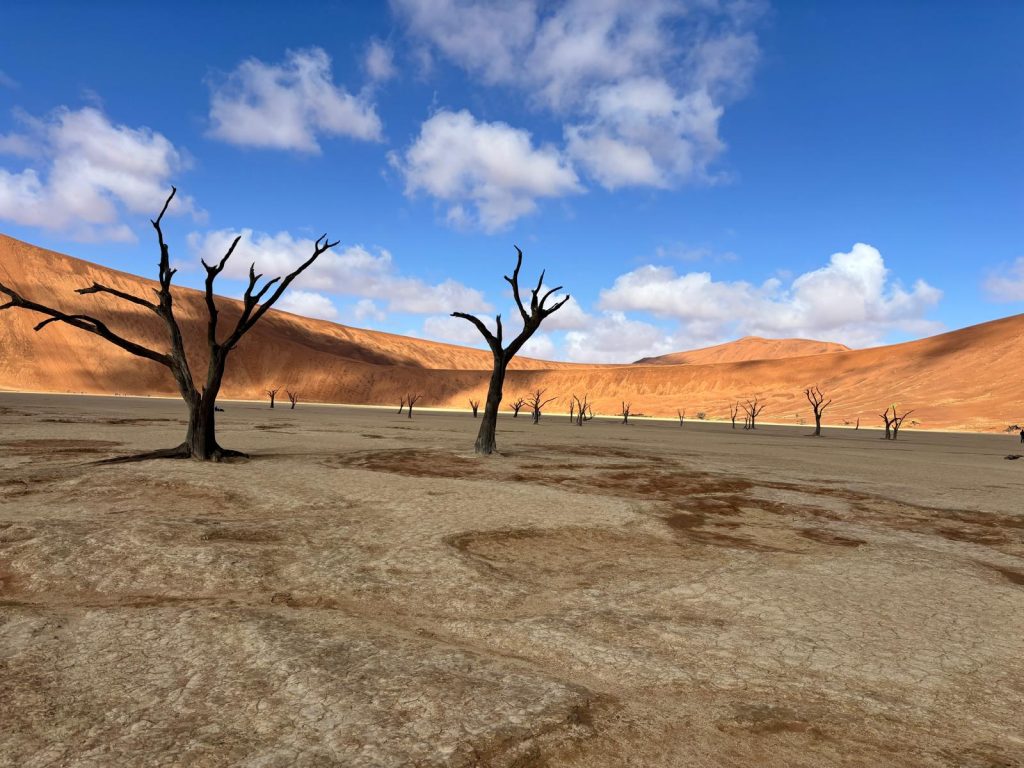


Day 4. Pelican Point and Sandwich Harbour. The main reason why we choose to stay in Walvis Bay and not the more touristic Swakopmund was because of a day trip planned for today. Walvis Bay was closer to the attractions included in the trip, which meant leaving later and getting back earlier, compared to Swakopmund. We opted for a tour to Pelican Point and the Sandwich Harbour. We booked this via the getyourguide app, and the whole day was fantastic. Our driver/guide shared so much info with us and was super friendly and fun. He picked us up early morning (about 9AM) and first we stopped to get the packed brunch and lunch (including soft drinks) from a coffee shop located on the waterfront. We could already see some seals swimming in the ocean. Then we drove to the flamingo lagoon and then to the salty pink lakes. But the main attraction was waiting for us at Pelican Point. We drove past the Pelican point Lodge with its one of a kind black and white lighthouse. Jackals wander the sands here in search of wounded seals and waves crash into the shore bringing in fossilized giant oysters. Pelican point has its very own fossilized oyster reef dating back to the Miocene and Pliocene epochs, a testimony to how the climate has changed over more than 10 million years. You might think that Pelican Point is famous for pelicans, but instead the peninsula is home to thousands of cape fur seals that lie on the beach basking in the sun. It was now time to jump into the water (well we used the kayaks) and paddle amongst the hundreds of seal (mostly pups) that were curious enough to jump on the kayaks or splash around.


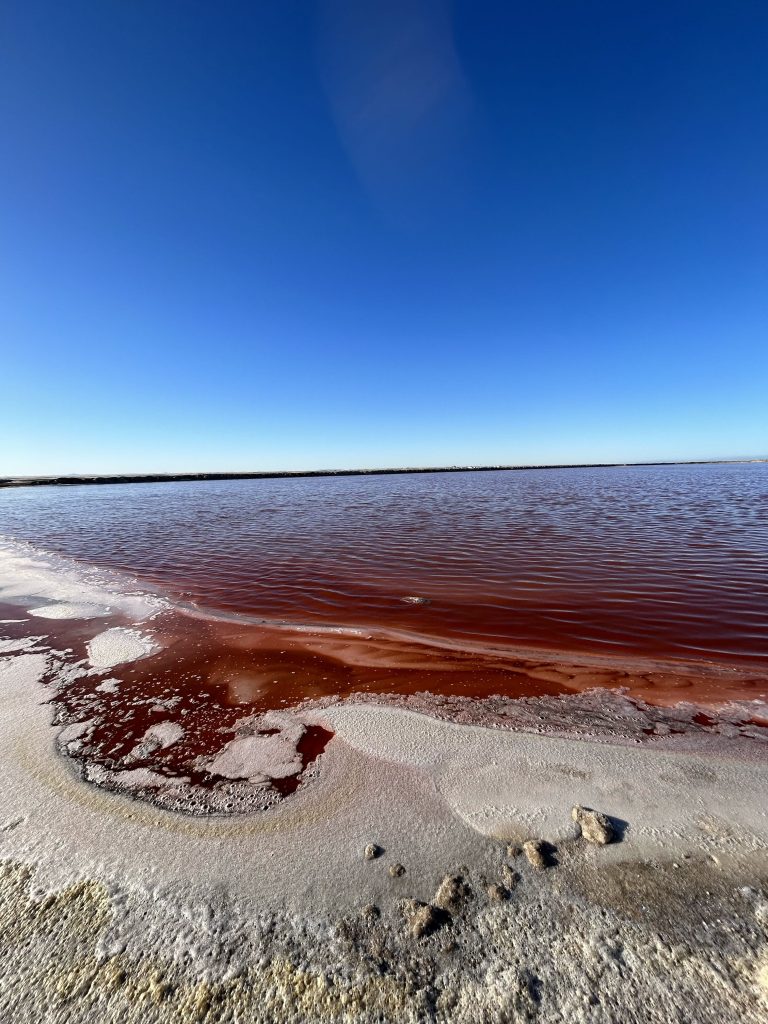

After kaykaing for a while we had a lovely brunch on the beach and continued towards Sandwich Harbour. The tour includes some dune bashing, as well as driving on the “highway” – the shore. For lunch, we had some grilled meat (Namibian braai) including some game meat. We stopped to see the water spring (in the desert) deep underground, with tunnels dug by the jackals. We were each given a small bottle to fill with sand and our guide gave Eric a magnet to collect magnetite grains from the sand. We returned home by driving through an area filled with shrugs, where we could spot some antelopes and gazelles.
Our guide was Volker and we booked through https://tinyurl.com/yc2rzn2s. Expect to pay around 170 euro/adult.
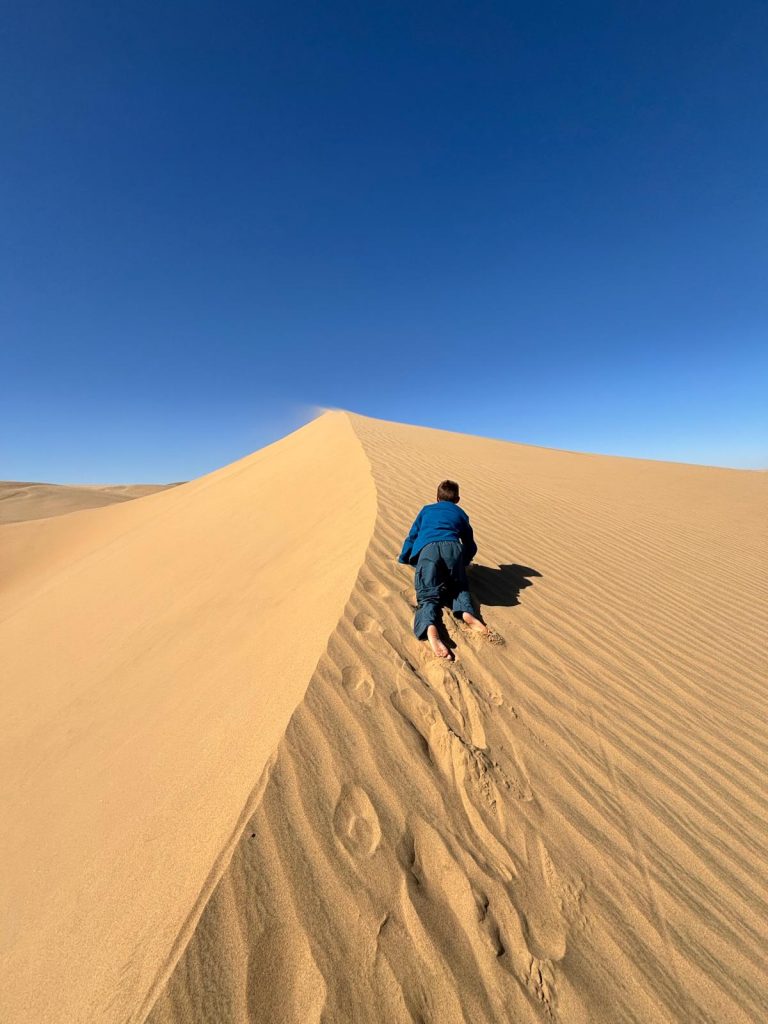
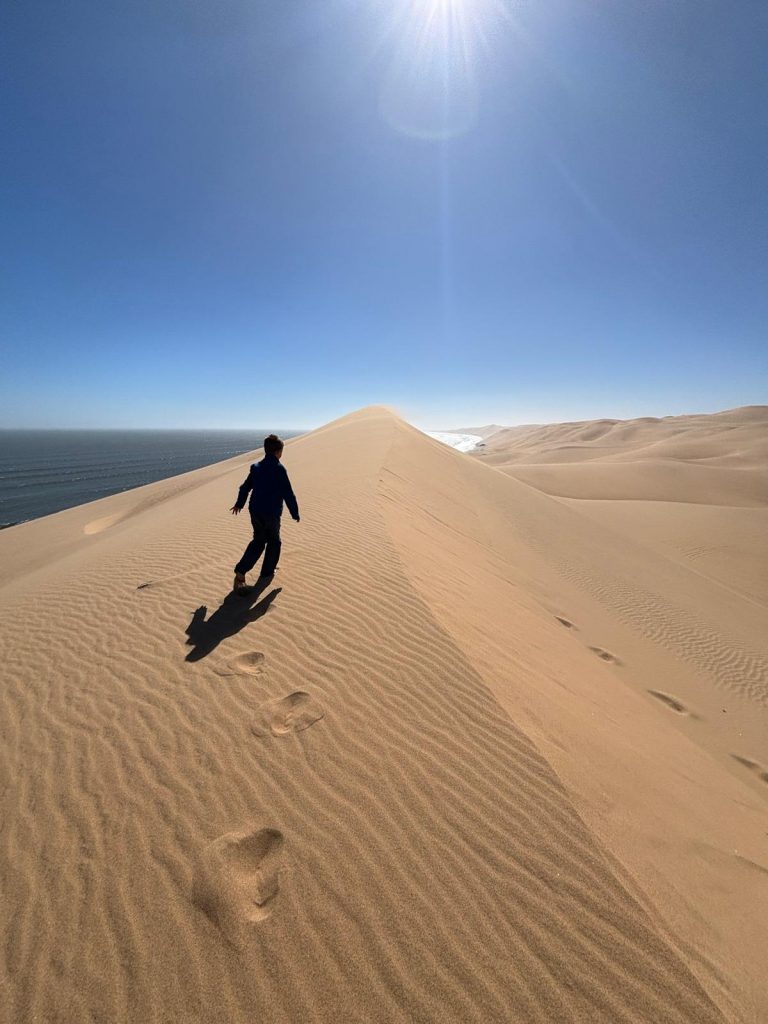
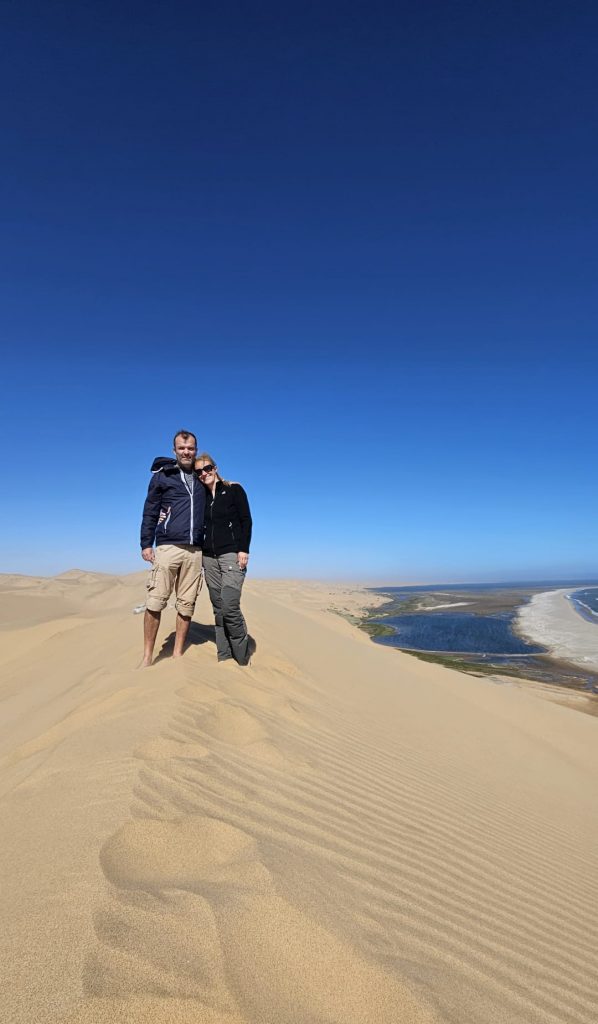




Accommodation: Anas Inn Walvis Bay (same as previous night). Dinner: Our driver recommended a very nice restaurant, in one of the oldest buildings of Walvis Bay. We had a lovely dinner with fresh oysters and sea food at Godenfang Restaurant, which was located no further than 5 minutes walking from Anas Inn.


Day 5. Swakopmund and on the road to Twyfelfontain. We left Walvis Bay early morning and drove to Swakopmund. We parked on the main street next to the Tug restaurant and visited the small Snake Park, an indoor-outdoor museum housing all sorts of snakes (some very venomous) and mostly from Namibia. They claim to have the largest collection of Namibia’s indigenous snakes and other reptiles. The museum is opened from 9Am to 4PM. More info here: https://www.facebook.com/livingdesertsnakepark/. Google maps location: https://maps.app.goo.gl/pgzN6bYZajWaqNnC8.
The Snake Park is conveniently located next to Swakopmund waterfront and a beautiful promenade lined with trees and home to a other of guineafowls. We followed the main alley of the promenade up to its very end to discover a local craft market. The vendors sells lots of wooden crafted animals at good prices. Google maps location: https://maps.app.goo.gl/AFxswNJuRV5yX2ip8.
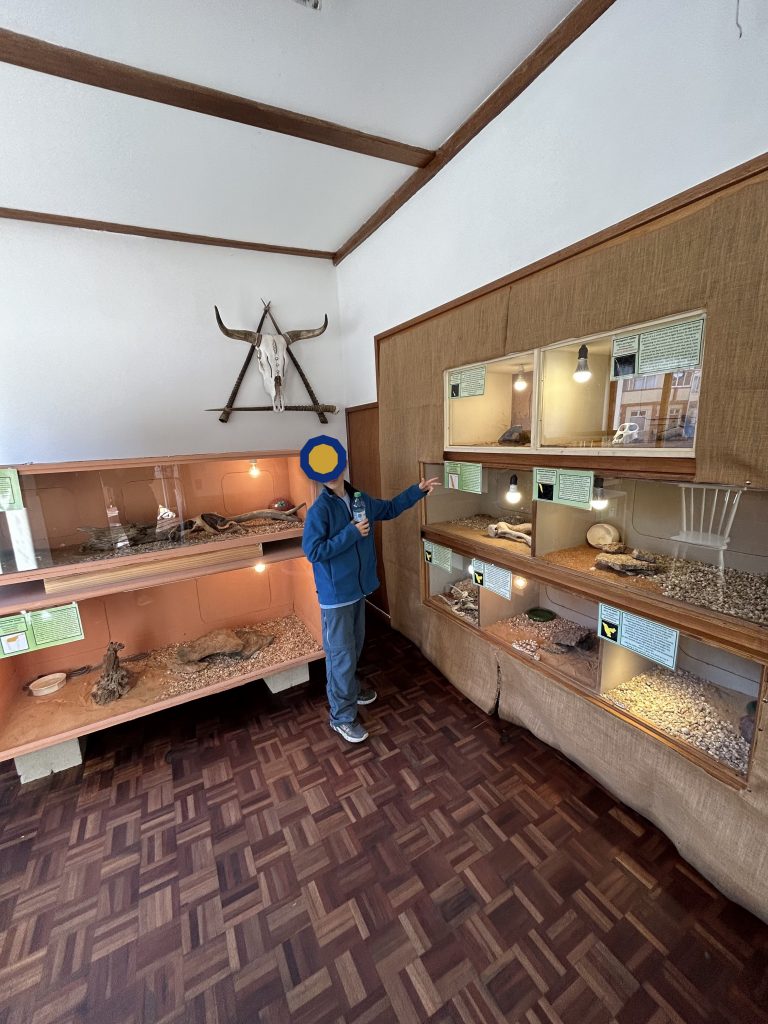
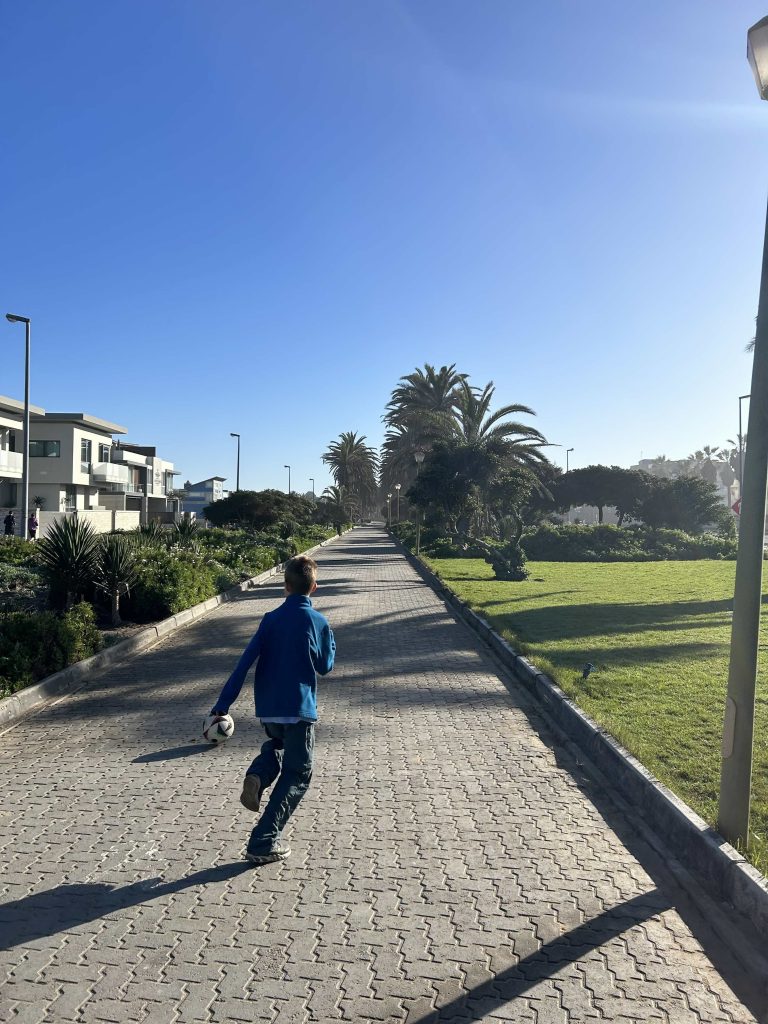
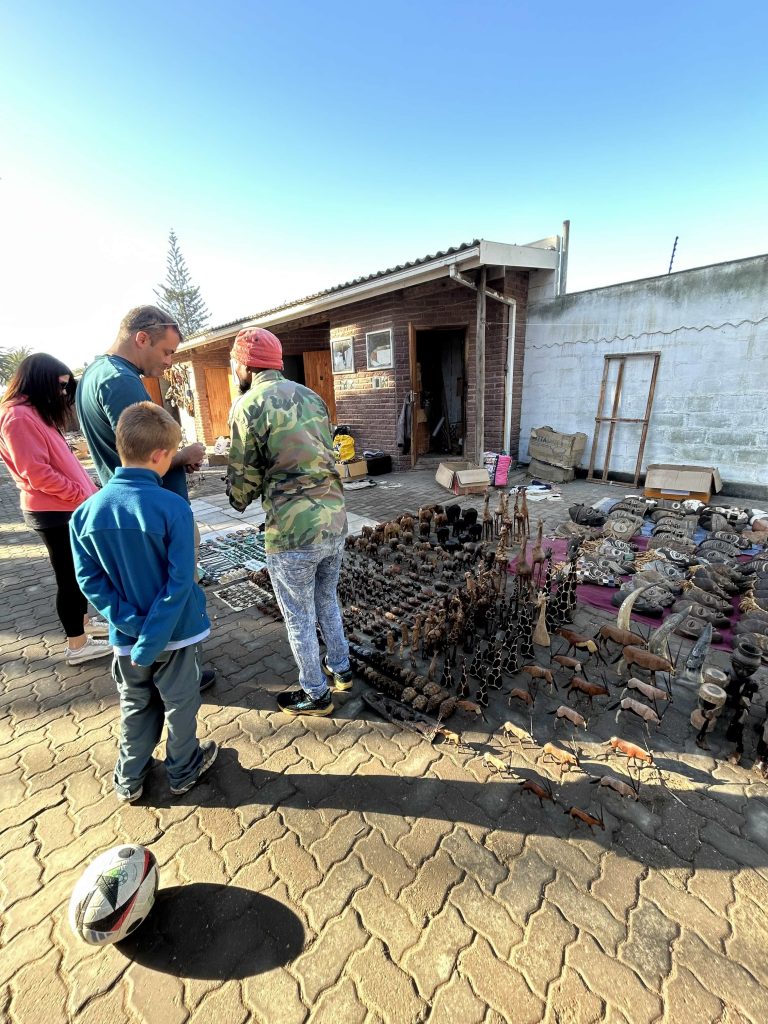
It’s best to refill the gas tank if you follow our itinerary. From Swakopmund we drove for 4h to reach our next accommodation, close to Twyfelfontain. The drive takes you on shore of the ocean towards Henties Bay and part of the Skeleton Coast. From Henties Bay we drove inland on a paved road that strechtes almost up to Uis. From here up to Khorixas and beyond towards Twyfelfontain the road is gravel, but very much ok (80-90km/h).
The Skeleton Coast of Namibia might be hostile, but the views are incredible. Dotted with shipwrecks and whale bones, part of it is freely accessible and part of it requires a permit. The local San people referred to the Skeleton coast as The Land God Made in Anger, but I beg to differ, as it was one of my favourite spots in Namibia. Just check the aerial footage below.
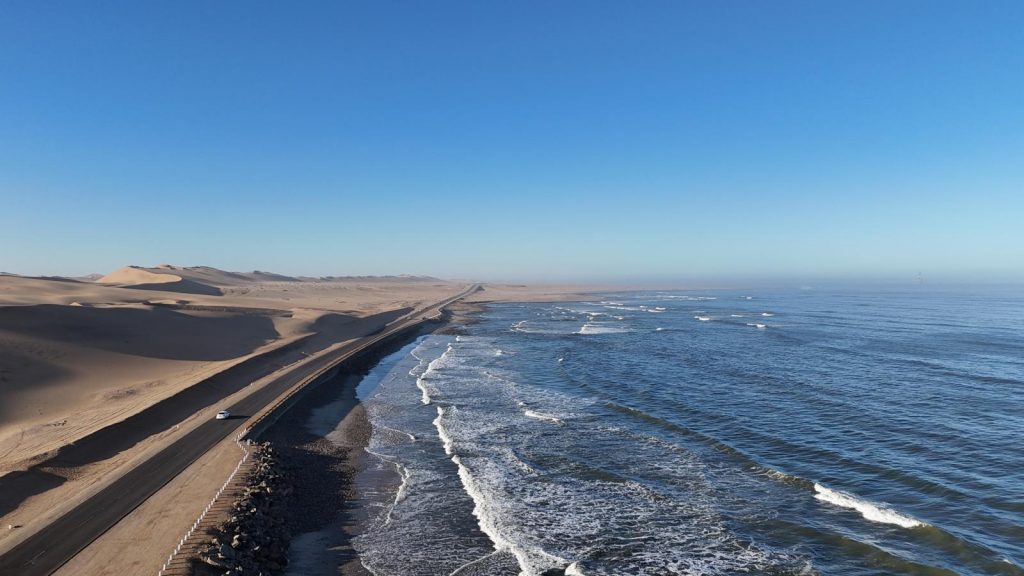
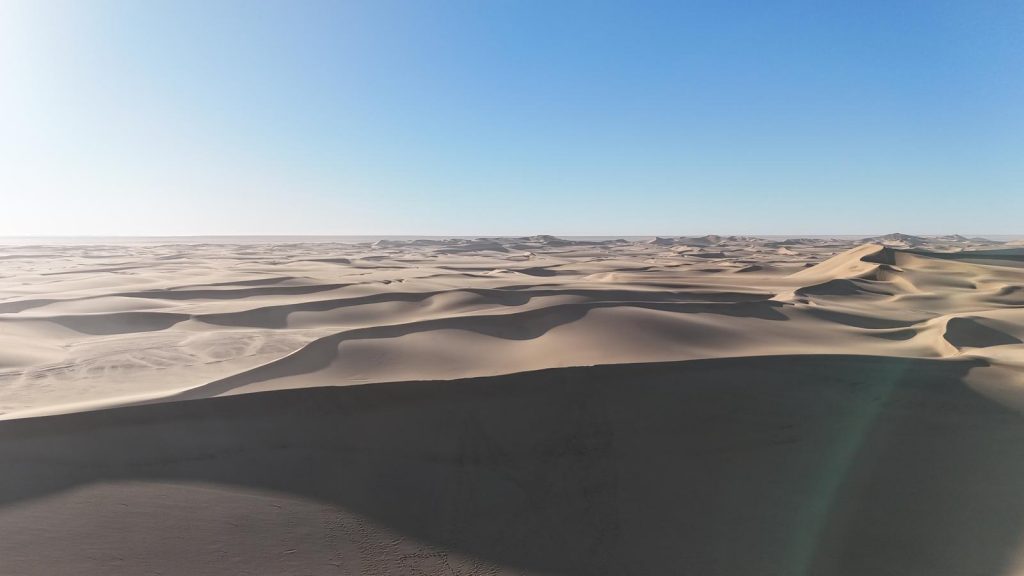
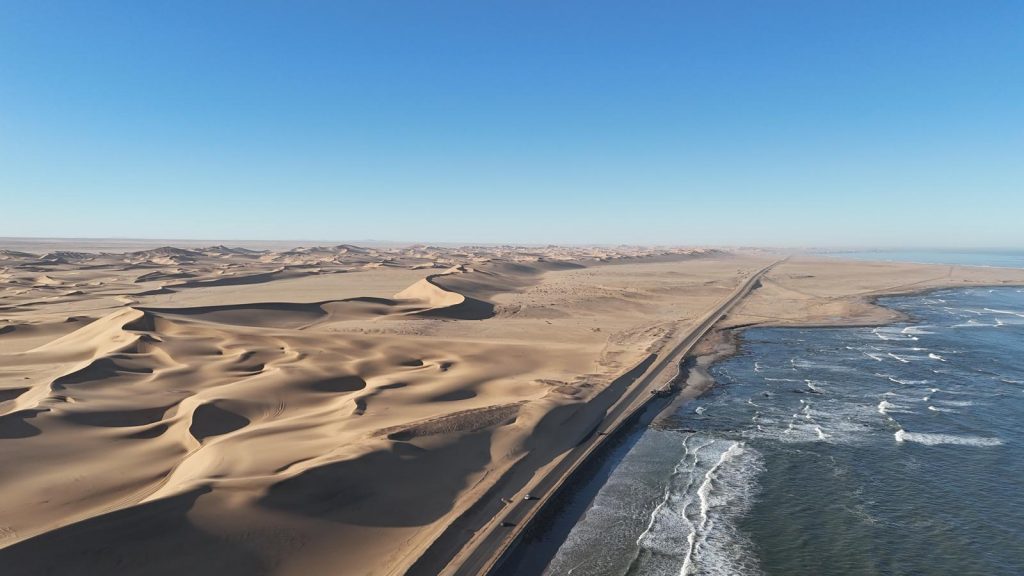
Accommodation: Petrified Forest Restcamp (168 euro/night ). Dinner: Home cooked by our hosts at the Petrified Forest Restcamp. Both the accommodation, breakfast and dinner are to be paid in cash. The accommodation is in a remote location. The hosts are a lovely couple, Lettie and Eddie. They run a small coffee shop, but recently built two small lodges, equipped with air conditioners, clean and modern bathrooms, a microwave and fridge. The sunset and sky is absolutely amazing. Eddie knows a lot about the desert adapted elephants. The hosts are very welcoming and it was great to hear their stories.
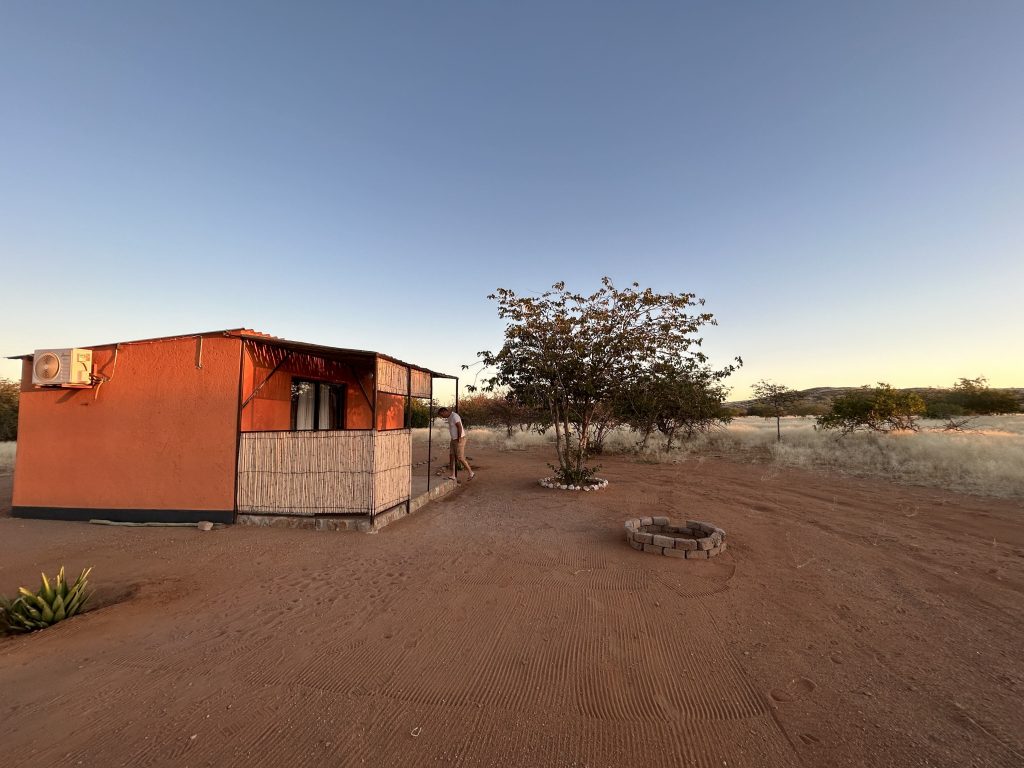


Day 6. Twyfelfontain, desert adapted elephants and the Damara living museum. From our accommodation we drove for 1h on a gravel road to reach Twyfelfontain.
Twyfelfontein is a Namibian site of rock engravings dating back almost 6000 years. Most petroglyphs were engraved by the hunter-gatherers that lived in the area. The sandstones provided for a good means to portray the animals that lived in the valley.
The most common petroglyphs represent the giraffes which were believed to bring rain. For this reason, they were not hunted. Maps with waterholes are also engraved on yhe sandstones. The most famous petroglyph is however the lion with human palms, a mystical representation of the shaman. Scientists nowadays believe that the engravings were used as a means to educate and that the site also had religious significance. Rock engravings depicting seals and penguins demonstrate that the hunter-gatherers wandered the territory up to the Ocean and South Africa, but kept returning to Twyfelfontain.
The site cam be visited solely with a tour guide. The visit usually lasts about 45min-1hour. The visit assumes climbing on rocks. Sturdy shoes recommended. Prices: 270NAD/adult, 220NAD/child. Definitely worth a visit.
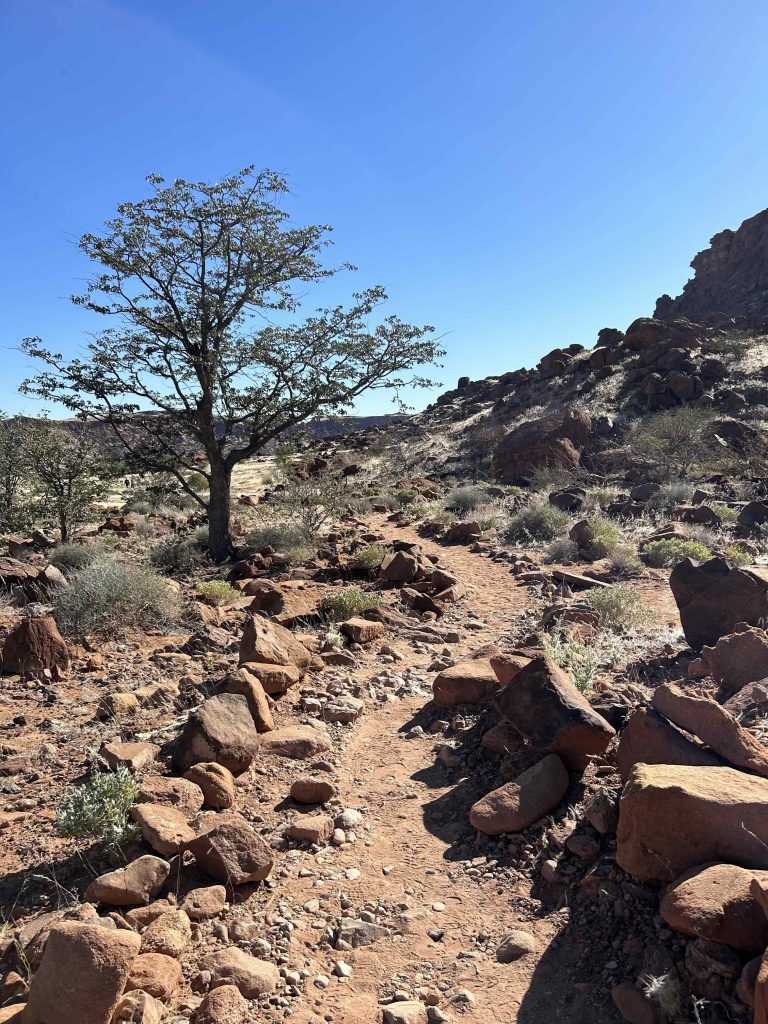
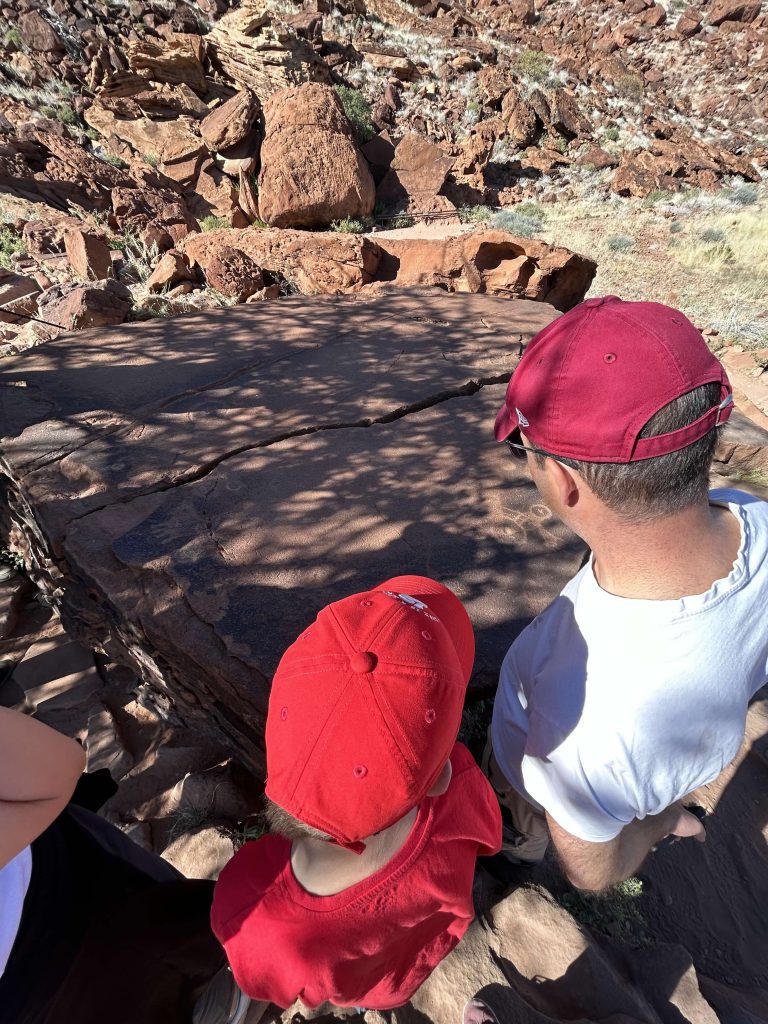

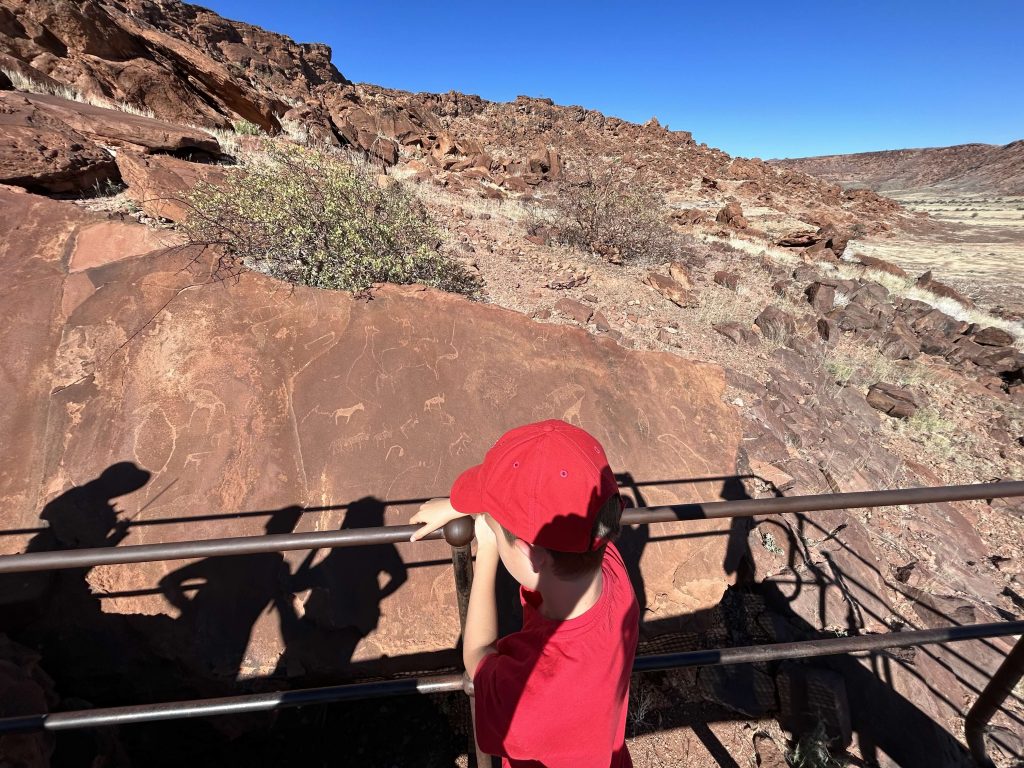
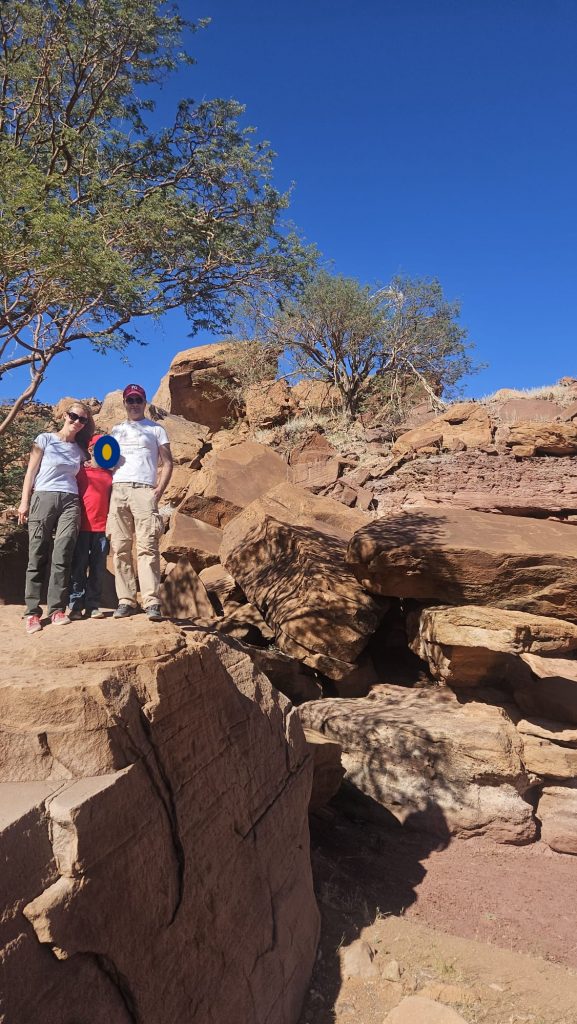
Northern Namibia is home to one of the two populations of desert elephants. These have adapted to dry land and can be encountered near the Twyfelfontain area. Most lodges and travel apps offer various safari options, but they usually imply following a guide on the dry riverbed of the Huab river. Costs can be as high as 1500 NAD/adult.
Instead, at Twyfelfontain, once we parked our car a young man, approached us and asked if we were interested in a safari. He was in the same group as the staff, so we decided we should give it a try.
After the visit, the guide step inside our car and directed us towards the riverbed. Two other cars were doing the same safari. We drove around (self drive) on the dry river bed searching for the desert elephants. Half an hour later, we saw them. We stopped the engines and were given instructions on what to do if the elephants become aggressive. We were very very close. Once they passed us, we slowly followed them around. Took some more pictures and returned. The whole safari took a little bit more than 1h. And the guide gave us a really good price. 1000 NAD/car (3 adults and 1 child).
One of the coolest things we did in Namibia! And also one of the most terrifying (the elephants were very wary towards us).
According to the Desert Elephant Conservation agency there are only about 150 elephants left.


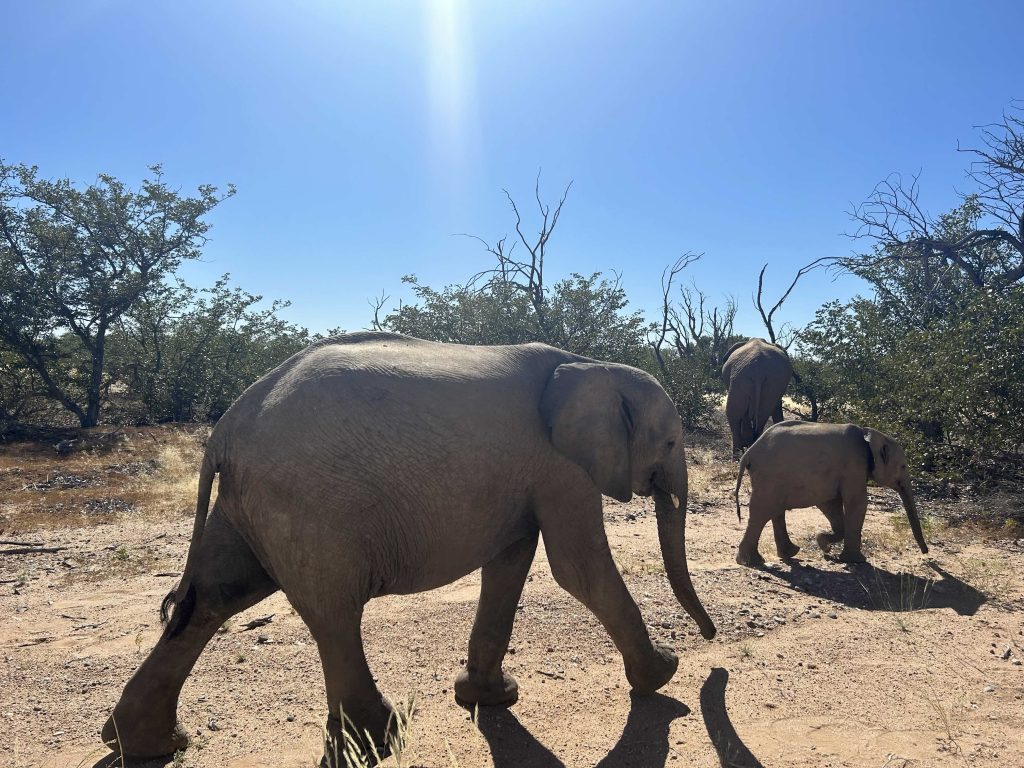
The area around Twyfelfountain is packed with attractions. Apart from the rock engravings, we were also interested in visiting a living museum. These are reenactments of how one of the oldest nations in Namibia lived their life, the Damara people. On the road there are several signs pointing in the direction of various “living museums “, but we have opted to visit the very first museum of this kind.
It’s location is close to the rock engravings making it ideal for a stop. They have various visiting options, but we choose to see life in the village. We were greeted by a bushman that walked us to the entrance of the museum on a path cut between two towering stone walls. Then a guide took us around the museum and explained what we were seeing: a blacksmith workshop, jewelry or clothing making, fire making, traditional dance and singing. My favourite was the medicine workshop, where the lady spoke click language, adding to the authenticity of the museum.
Overall a great experience that we highly appreciated. The museum is small, the tour lasts less than 1hour. Opening times: sunrise to sunset, like all other attractions in Namibia. Prices: 130 NAD/adult, 65 NAD/child (3-12 years). More info: https://www.lcfn.info/damara/programs-rates. Location: https://maps.app.goo.gl/KUWpWsKDLokoQcoc7?g_st=ipc
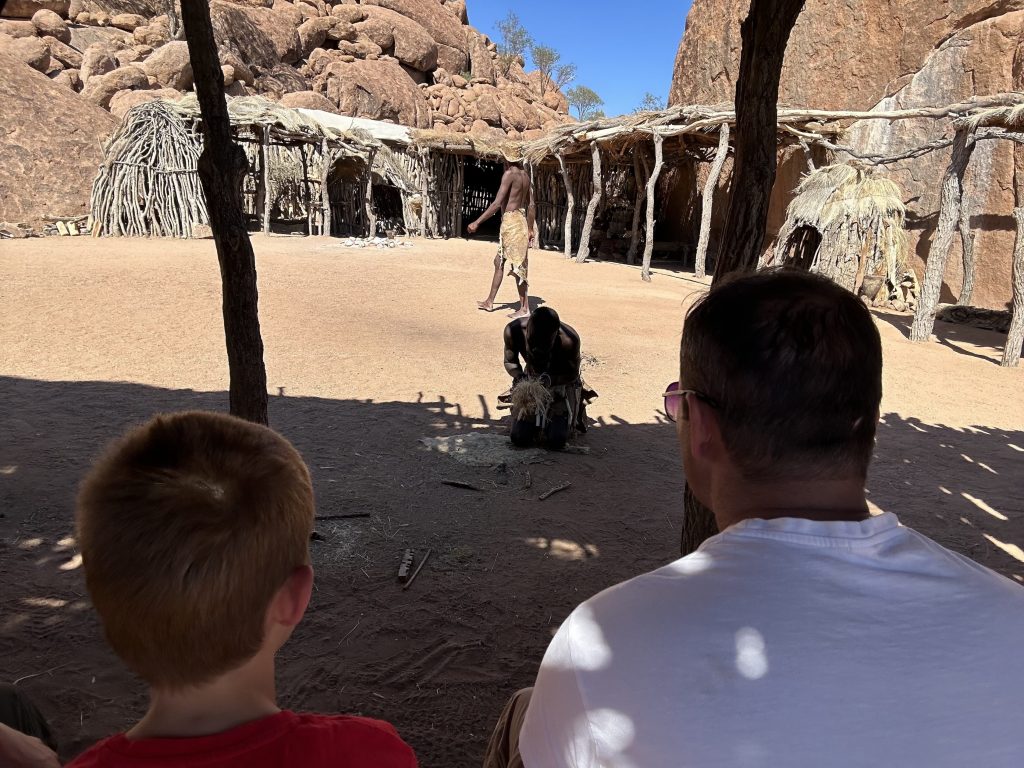

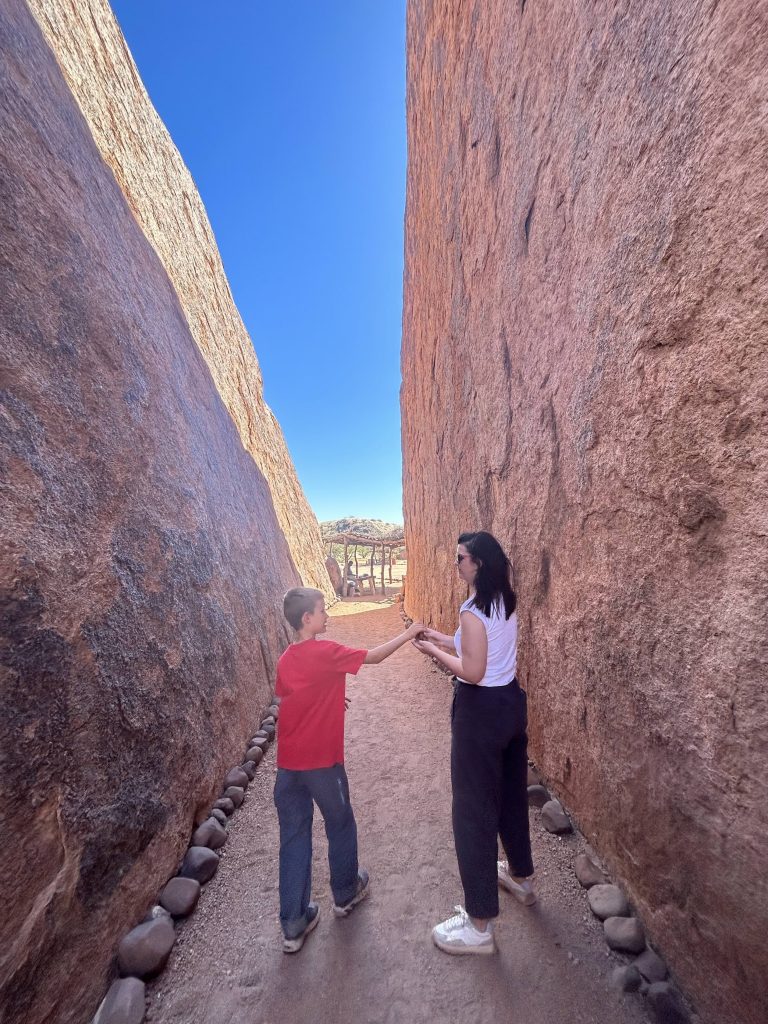
Initially, we had planned to visit the Petrified Forest, but upon reading multiple reviews online we decided to skip it. The petrified forest apparently consists in 4-5 trees lying on the ground. While it might have been interesting we decided that the entry price (270 NAD/adult) vs what they offer was not balanced.
We drove instead to Outjo to get to our accommodation. Fuel up in Outjo to get ready for the safari in Etosha.
Accommodation: Sasa Safari Camp and Tours (309 euro/ 3 nights, without breakfast ). Dinner: Outjo doesn’t have too many restaurants. But we chose to dine in town for a different vibe compared to the camp we were accommodated in. We ate an oryx steak at the The Farmhouse Restaurant Beergarden, which was delicious. They did mess up our order the second time we went there, but the food was delicious and they compensated with free beer for their mistake. On one night we barbecued at our camp (we bought game and beef steaks from the Spar supermarket in Outjo. Also good for groceries shopping for breakfast and lunch – picnic in Etosha).



There are several lodges on the way from Outjo to Etosha, but we felt that Sasa Safari Camp was decently priced for what they offered. The rooms are basic, with hot water and electricity to charge your phone. The staff was amazing. They set up the fire for our barbecue and arranged a table for us. They did all the cleaning and in the end they offered us malva pudding (traditional desert, without any charge).
Days 7-8. Etosha. From our accommodation the drive to Ombika, the gate way to Etosha takes about 1h on a paved road. If you’ve never tried a self-drive safari… then Etosha is right for you! All you need is a vehicle (not even a 4×4), a map (you can either buy it at the entry gates or use the etosha app https://www.etosha-app.com) and a lot of patience.
The roads in Etosha are mostly in good condition and there’s a 60km/h speed limit. The road from Ombika to Okaukuejo is paved and the main road in Etosha is gravel, but in very good condition. The smaller roads leading to various waterholes are clearly marked and directions are clearly signposted.
If you’re accommodated outside the park, it’s best to arrive at the gates as early as possible. We entered via the Anderson/Ombika gate. Here, the car is inspected as you are not allowed to carry raw meat inside the park or drones. Once they checked and gave us the permit, we were allowed to enter the park and proceed to Okaukuejo. This is one of the campsites in the park. The ticket office is located in Okaukuejo close to the gate, on the right hand side. Once we paid the tickets (free for kids below 16, 150 NAD/adult and 50 NAD/car) we were free to wander the roads of the park. No off road driving is allowed. Gas stations available in Okaukuejo, Namutoni and Halali.
In Etosha, you are guaranteed to spot zebras and springbok. They are basically everywhere. Cats are more difficult to spot.
Itinerary inside Etosha. Day 1. We drove from Okaukuejo on C38 (which is in good condition) and stopped at several waterholes. The best one was Homob, where we had breakfast (in the car!), while watching the numerous springboks and zebras and the occasional wildebeest. We continued on C38 and stopped at Sueda and Salvatora, which were almost deserted. Our next stop was Rietfontain, which was supposed to be good to spot cats. But it was almost deserted. Very little water. We continued on C38 and took the Halali road to get to the Halali camp. In Halali, there’s a waterhole (Moringa) that we hiked to. But there were only few animals there. It was also well past 11AM. It’s a good spot however to stop and have lunch. Picnic is possible as well and the shop is well stocked. This part of Etosha is more like a forest and animals are more difficult to spot. We continued from Halali to the Rhino Drive, but were unsuccessful in seeing anything special. The forest is pretty dense. We returned to Okaukuejo in the afternoon and stopped at the Okaukuejo waterhole (at about 4PM). It was a good decision since less than 10-15 minutes after we arrived, a rhino and its baby came to the waterhole. Lots of springboks and zebras as well. On our way out of Etosha, from Okaukuejo to Ombika we’ve seen lots of game, including some 15 giraffes (only in the afternoon).
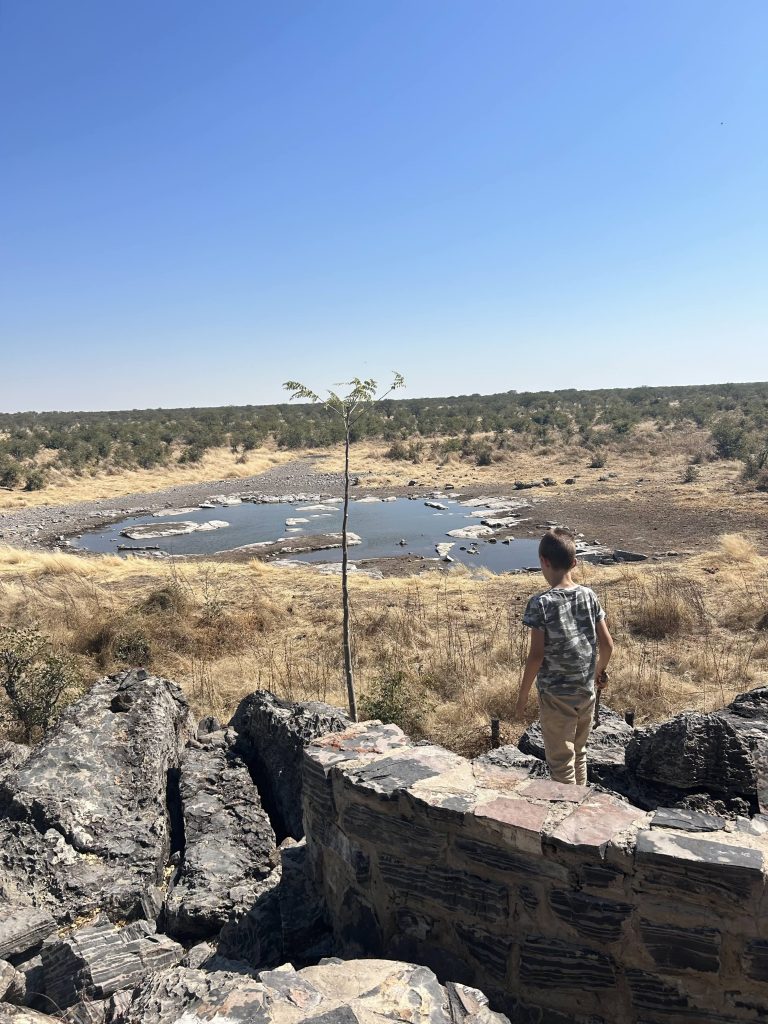



Itinerary inside Etosha. Day 2. Today we decided to spend only the first part of the day in the park and return for barbecue earlier to Sasa camp. We started in Okaukuejo, and drove towards the airport and Okondeka waterhole. This part of Etosha is more like a plain and the animals are easier to spot. Lots of zebras, antelopes and gazelles to be seen here. Hyenas and jackals as well. From Okondeka we drove inland, away from the pan and on the Adamax road. We were very lucky to see a lion and 4 cheetahs cubs. We arrived back at the Okaukuejo waterhole in mid day and the waterhole was packed with animals.
Personal conclusion. To be honest, the best waterhole was Okaukuejo. The waterhole is floodlit and great during the evening. But, since we were not accommodated inside the park, we had to exit before sunset. Staying inside the park, in Okaukuejo, is obviously possible, but the availability is limited. They do have chalets right next to the waterhole and I can imagine it’s great to stay on the terrace of your own chalet and watch the herds of animals coming and going. Normally, the waterhole should have the best activity early morning and after sunset, but it was heavily visited by numerous zebras, springboks, wildebeest and other gazelles and antelopes even at noon. In the afternoon, we even spotted a rhino with their baby.



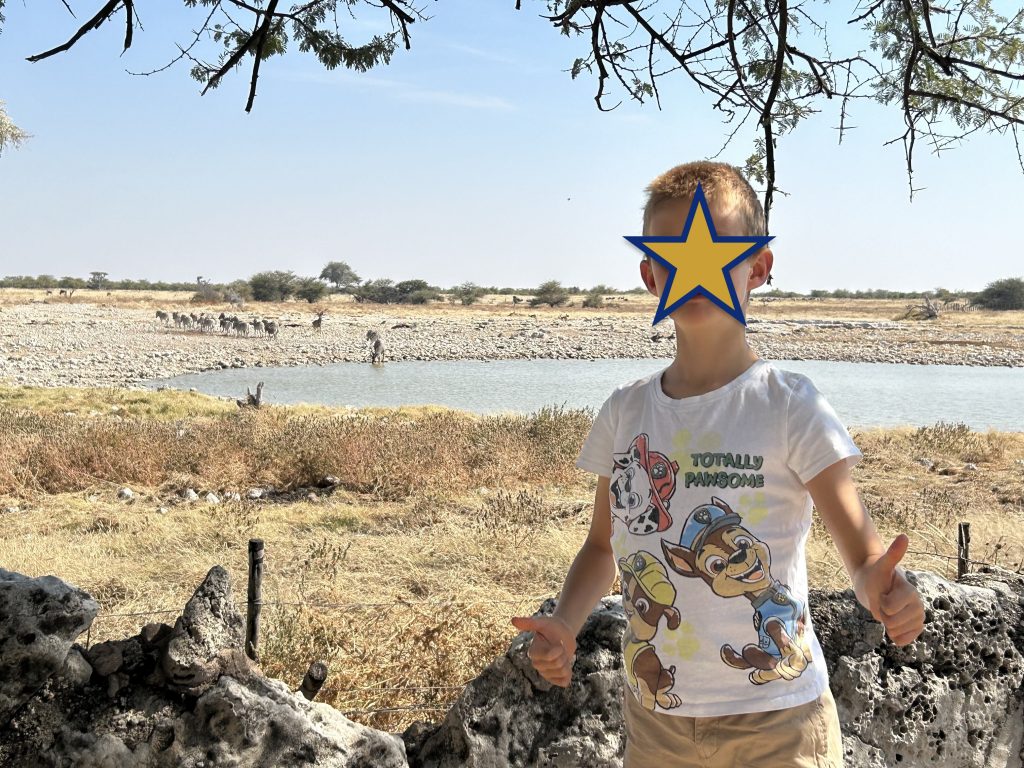
Day 9. Cheetah Conservation Fund. We drove about 1h30min to reach the Cheetah Conservation Fund, a slight detour from the paved road that links Outjo to Windhoek. The cheetahs of Namibia are under constant threat, mostly from farmers wanting to protect their livestock.
The Cheetah Conservation Fund was established to rescue the animals injured or caught and to offer them a safe environment. The CCF offers guided jeep safaris through their compound, getting close to the cheetahs. The tours are very informative and last for about 1 hour. At the end of the tour, we got to see the dogs they trained to sell to the farmers for protection against wild animals. Apparently they are 80% effective and this way both the livestock and the cheetahs are protected. They also raise goats (which they do not feed to the cheetahs ![]() ), but rather use the milk to produce cheese or icecream.
), but rather use the milk to produce cheese or icecream.
We booked our tour online, a day before. We had to select the hour for the tour, but we called on the way there and had no problem modifying the tour starting time. The museum was also nicely organized and super fun amd educational, at the same time.
If you happen to be on site for the feeding time (2PM), the tour includes this activity as well. They also have a “cheetah run” activity, where you witness the sprint of the cheetah, but it’s only available for people older than 16. They do this activity, to simulate the hunting and to keep the cheetahs fit.
Book here: https://cheetah.org/
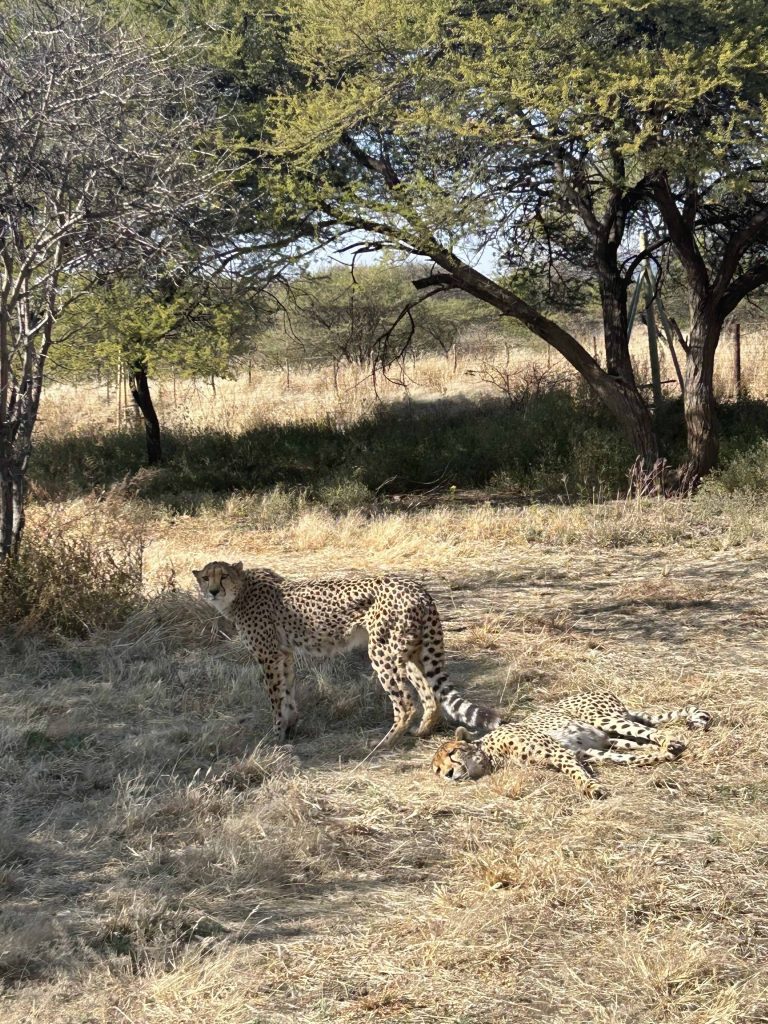
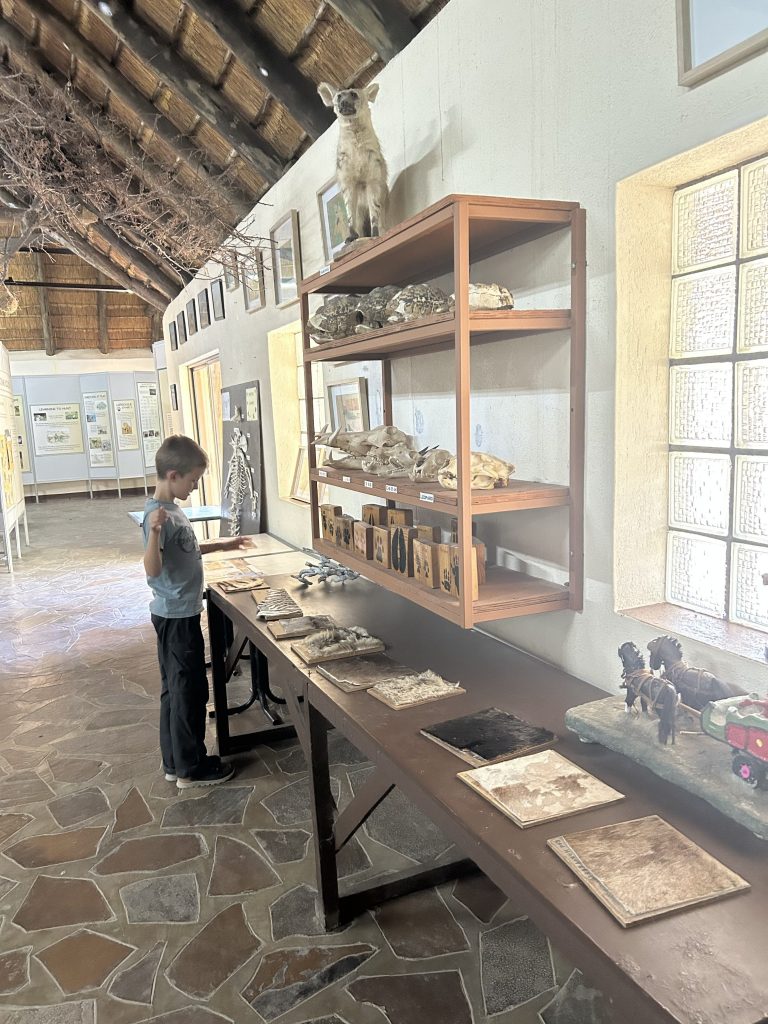


Accommodation: From the CCF we drove for about 3h to reach our accommodation, the road is paved. For our last night in Namibia, we booked a superb luxury tent surrounded by wildlife at the Windhoek Game Camp. I’m sure you’ve heard of the Giraffe Manor near Nairobi. For a tenth of the price compared to the Giraffe Manor, at the Windhoek Game Camp we had a fabulous breakfast, relaxed by the heated pool and hiked surrounded by oryx, springboks and giraffes. We paid 130 euros for a luxury tent + breakfast. In July the temperatures drop to a few degrees, so it can get a bit cold (5 degrees when we visited). To keep you (partially) warm, the beds are equipped with electrical blankets. A 3-course dinner set menu costs an additional 385 NAD.

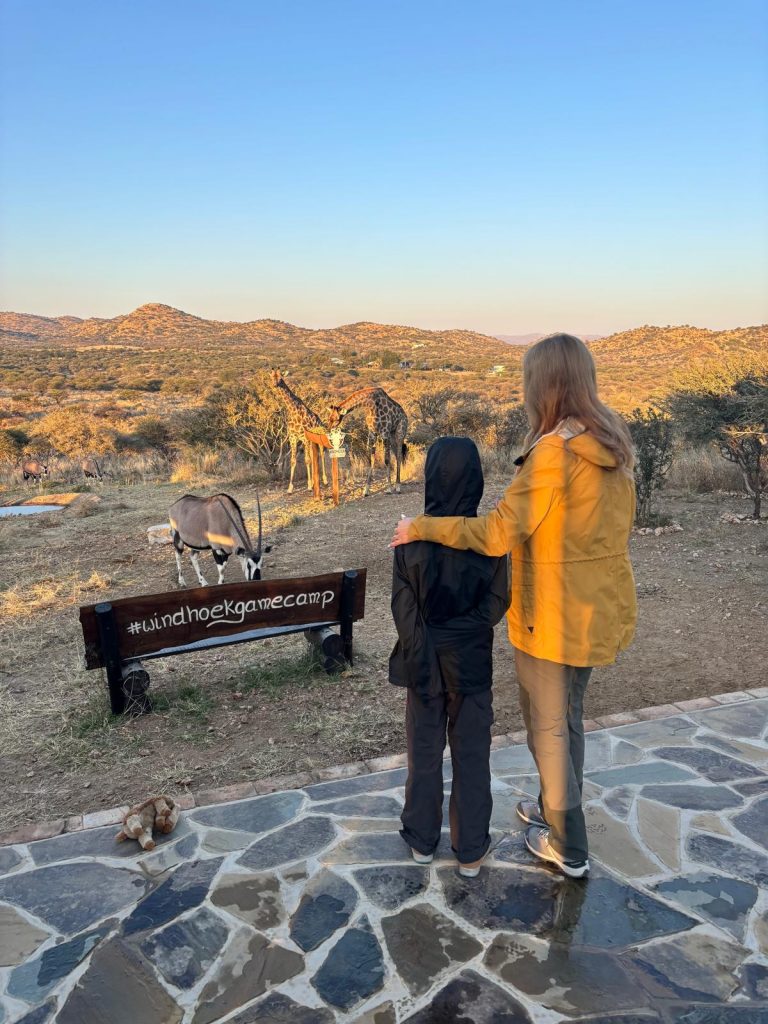
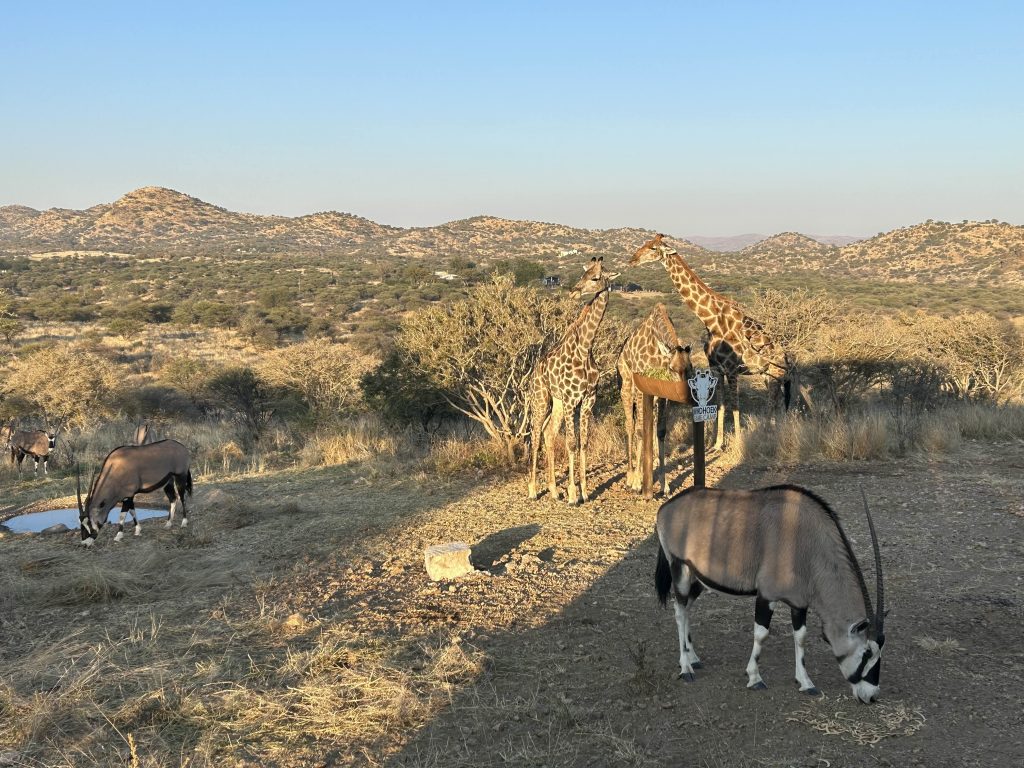
Day 10. Windhoek Game Camp relaxation, late lunch at Joe’s Beerhouse and back to the airport. Our flight was bound to leave later today in the evening, which meant we had plenty of time to enjoy and relax at the Windhoek Game Camp. Feeding times for the giraffes and oryx are at 8AM, but the giraffes and oryx roam the vast garden of the camp anytime of the day and frequently return to the camp. They are easy to spot during the entire day, even from the outdoor terrace of the tents. We went on a hike in the garden and relaxed by the pool, before driving for 25min to Windhoek to have a late lunch at Joe’s Beerhouse.
Joe’s Beerhouse location: https://maps.app.goo.gl/wAayQyQNKfZoVY2v8. Parking at the back of the restaurant is free of charge (just follow the signs). We ate game meat skewers (oryx, kudu, springbok, zebra and giraffe), but several other options are available.
The car rental company office is located 20 minutes away. After inspecting the car, they drove us to the airport located 50 minutes away.







0 Comments